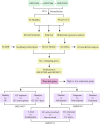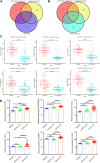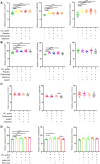Identification of Pharmacological Autophagy Regulators of Active Ulcerative Colitis
- PMID: 34925026
- PMCID: PMC8672246
- DOI: 10.3389/fphar.2021.769718
Identification of Pharmacological Autophagy Regulators of Active Ulcerative Colitis
Abstract
Background: Ulcerative colitis (UC) is a chronic recurrent disease of unknown etiology. Recently, it has been reported that autophagy-related gene polymorphism is closely associated with increased risk of UC, and the therapeutic effect of some UC drugs is mediated by regulating autophagy pathways. This study aims to identify pivotal autophagy-related regulators in UC pathogenesis and provide novel molecular targets for the treatment of active UC. Methods: Gene expression profiles and clinical information of active UC patients were obtained from GEO databases. CIBERSORT was adopted to evaluate the immune cell infiltration. We used weighted gene co-expression network analysis (WGCNA) and differential expression analysis to identify the pivotal modules and genes associated with active UC. Subsequently, we conducted validation in the validation set and explored its relationship with commonly used UC therapeutics. Results: 36 healthy controls and 46 active UC patients have been obtained from the training set of GSE53306, GSE87466, and GSE134025. There were 423 differentially expressed genes (DEGs) found, which dramatically enriched in autophagy-related pathways. And more infiltration of mast cells, activated T cells, dendritic cells, and M1 macrophages were observed in the intestinal mucosa of active UC, while more infiltration of resting immune cells and M2 macrophages in healthy controls. WGCNA indicated that the turquoise and blue modules were the critical modules. CASP1, SERPINA1, and CCL2 have been identified as the hub autophagy-related genes of active UC, after combining DEGs and 232 autophagy-related genes from HADb with the genes of turquoise and blue modules, respectively. We further verified that CASP1, SERPINA1, and CCL2 were positively associated with active UC and served as an autophagy-related biomarker for active UC. Moreover, increased SERPINA1 in the involved intestinal mucosa was reduced in patients with active UC who responded to golimumab or glucocorticoid therapy. But, neither CASP1, SERPINA1, and CCL2 were changed by treatment of 5-aminosalicylic acid (5-ASA) and azathioprine. Conclusion: CASP1, SERPINA1, and CCL2 are autophagy-related hub genes of active UC. And SERPINA1 may serve as a new pharmacological autophagy regulator of UC, which provides a new target for the use of small molecules targeting autophagy in the treatment of active UC.
Keywords: WGCNA; autophagy; biomarkers; pharmacology; ulcerative colitis.
Copyright © 2021 Qiu, Liu, Fang, Zhang, Wang, Peng, Chen, Liu, Wang and Zhao.
Conflict of interest statement
The authors declare that the research was conducted in the absence of any commercial or financial relationships that could be construed as a potential conflict of interest.
Figures






Similar articles
-
Exploring the autophagy-related pathogenesis of active ulcerative colitis.World J Clin Cases. 2024 Mar 26;12(9):1622-1633. doi: 10.12998/wjcc.v12.i9.1622. World J Clin Cases. 2024. PMID: 38576744 Free PMC article.
-
Exploring Pyroptosis-related Signature Genes and Potential Drugs in Ulcerative Colitis by Transcriptome Data and Animal Experimental Validation.Inflammation. 2024 Dec;47(6):2057-2076. doi: 10.1007/s10753-024-02025-2. Epub 2024 Apr 24. Inflammation. 2024. PMID: 38656456
-
Identification of key genes and biological processes contributing to colitis associated dysplasia in ulcerative colitis.PeerJ. 2021 Apr 27;9:e11321. doi: 10.7717/peerj.11321. eCollection 2021. PeerJ. 2021. PMID: 33987007 Free PMC article.
-
Identification and Validation of Key miRNAs and a microRNA-mRNA Regulatory Network Associated with Ulcerative Colitis.DNA Cell Biol. 2021 Feb;40(2):147-156. doi: 10.1089/dna.2020.6151. Epub 2020 Dec 21. DNA Cell Biol. 2021. PMID: 33347387 Review.
-
The role of T cell potassium channels, KV1.3 and KCa3.1, in the inflammatory cascade in ulcerative colitis.Dan Med J. 2014 Nov;61(11):B4946. Dan Med J. 2014. PMID: 25370966 Review.
Cited by
-
Identification of gene signatures associated with ulcerative colitis and the association with immune infiltrates in colon cancer.Front Immunol. 2023 Jan 19;14:1086898. doi: 10.3389/fimmu.2023.1086898. eCollection 2023. Front Immunol. 2023. PMID: 36742294 Free PMC article.
-
Autophagy and its role in gastrointestinal diseases.World J Gastroenterol. 2024 Sep 28;30(36):4014-4020. doi: 10.3748/wjg.v30.i36.4014. World J Gastroenterol. 2024. PMID: 39351250 Free PMC article.
-
Berberine-loaded PLGA nanoparticles alleviate ulcerative colitis by targeting IL-6/IL-6R axis.J Transl Med. 2024 Oct 24;22(1):963. doi: 10.1186/s12967-024-05682-x. J Transl Med. 2024. PMID: 39448992 Free PMC article.
-
Association of alterations in transcriptomics and intestinal immune responses with Bifidobacterium longum BAA2573 in improving dextran sulfate sodium-induced colitis.BMC Gastroenterol. 2025 Aug 1;25(1):551. doi: 10.1186/s12876-025-04116-2. BMC Gastroenterol. 2025. PMID: 40750856 Free PMC article.
-
Identification of marker genes associated with N6-methyladenosine and autophagy in ulcerative colitis.World J Clin Cases. 2024 Apr 6;12(10):1750-1765. doi: 10.12998/wjcc.v12.i10.1750. World J Clin Cases. 2024. PMID: 38660076 Free PMC article.
References
-
- Atreya R., Zimmer M., Bartsch B., Waldner M. J., Atreya I., Neumann H., et al. (2011). Antibodies against Tumor Necrosis Factor (TNF) Induce T-Cell Apoptosis in Patients with Inflammatory Bowel Diseases via TNF Receptor 2 and Intestinal CD14⁺ Macrophages. Gastroenterol 141, 2026–2038. 10.1053/j.gastro.2011.08.032 - DOI - PubMed
-
- Bryan J. M., Fufa T. D., Bharti K., Brooks B. P., Hufnagel R. B., McGaughey D. M. (2018). Identifying Core Biological Processes Distinguishing Human Eye Tissues with Precise Systems-Level Gene Expression Analyses and Weighted Correlation Networks. Hum. Mol. Genet. 27, 3325–3339. 10.1093/hmg/ddy239 - DOI - PMC - PubMed
LinkOut - more resources
Full Text Sources
Research Materials
Miscellaneous

